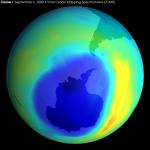Ozone Hole Recovery Could Reshape Southern Hemisphere Climate Change
A full recovery of the stratospheric ozone hole could strongly modify climate change in the Southern Hemisphere and possibly amplify warming of the Antarctic continent, report scientists from NOAA's Earth System Research Laboratory (ESRL) in Boulder, CO, the Cooperative Institute for Research in Environmental Sciences, and NASA

The authors used a NASA supercomputer model that included interactions between the climate and stratospheric ozone chemistry to examine how changes in the ozone hole influence climate and weather near Earth's surface. As ozone levels recover, the lower stratosphere over the polar region will absorb more ultraviolet radiation from the sun. As a result, intense westerly winds that block air masses from crossing into the continent's interior would weaken, and Antarctica would no longer be isolated from the warming patterns affecting the rest of the world. The influence of a full stratospheric ozone recovery on seasonal Southern Hemisphere climate will largely depend on how fast carbon dioxide and other greenhouse gases increase.
While average surface temperatures have been rising globally, the interior surface of Antarctica has exhibited a unique cooling trend during the Southern Hemisphere summer and fall, resulting from stratospheric ozone depletion during spring. The Montreal Protocol restricted production of ozone-depleting substances, starting in 1987, and scientists predict the ozone hole will recover completely by 2070.
Such changes in large-scale circulation patterns may ultimately have consequences for Australian and South American climate during late spring and summer. Australia could experience warmer and drier conditions, while areas in Argentina, Brazil, Uruguay, and Paraguay, could get wetter.
 Deep Sea Crabs
Deep Sea Crabs